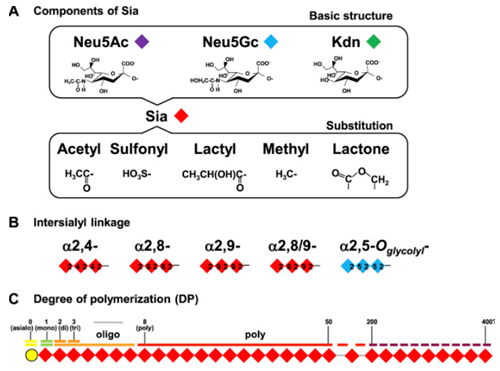Polysialylation Services
Sialic acid is a derivative of a group of neuraminic acids, and polysialic acid (PSA) is a monomer of sialic acid α- 2, 8 or α- 2,9-linked linear homopolymers, which are components of glycoproteins in some mammalian cells and extracellular polysaccharides in a few bacteria. PSA is attached to nerve adhesion molecule (NCAM), to CD36, and to synaptic cell adhesion molecule (SynCAM). It had been reported that polysialylated NCAM is very abundant in embryonic brain, which attracts much attention to numerous disease studies. PSA also plays an important role in cell adhesion, migration and synaptic formation, and in the development and remodeling of nervous system. Naturally PSA is a carbohydrate chain, biodegradable, highly hydrophilic in nature, and has no identified receptor in vivo. Therefore, post-translational modified therapeutic peptides and protein terminal sialic acid can improve the pharmacokinetics of drugs, reduce immunogenicity, and improve their overall efficiency.
 Figure 1. Structures of sialic acid and polysialic acid (Sato C, et al. 2020).
Figure 1. Structures of sialic acid and polysialic acid (Sato C, et al. 2020).
As an alternative of PEG, PSA has more potential application:
- PSA shows a good biodegradability, high hydrophilicity and non-immunogenicity;
- PSA is a part of glycoprotein and glycolipid, so it has better biocompatibility;
- PSA can also be used as a sustained-release material of protein drugs and a scaffold material for nerve repair surgery;
- With a manner similar to PEG in coating colloidal-carrier systems, PSA shows a good loading capacity;
- PSA linked with hydrophobic molecules could use in micelle preparation via self-assembly;
- Prolong the half-life for protein and polypeptide therapeutics.
With our drug development platform, Profacgen can develop polysialylation modification methods for our customer. If you are interested in our services, please feel free to contact us. We are looking forward to cooperating with you.
Reference
- Sato C, Kitajima K. Polysialylation and disease[J]. Molecular Aspects of Medicine, 2020: 100892-100892.